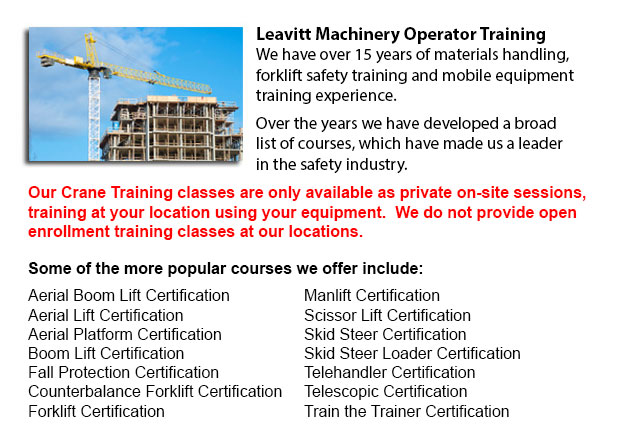
Overhead Crane Operator Training Vancouver - Our overhead crane operator training course is designed to teach staff the fundamentals of overhead crane/sling operation and pre-shift checks. Programs are taught by our professional trainers and consultants. Well-trained employees are more efficient and productive, that actually saves on expenses associated with property damage, merchandise damage, and accidents because of the utilization of incorrect operating procedures. Our overhead crane certification is customized for employees who have literacy barriers, reducing certification time by 50 per cent.
Overhead cranes are suitable for specific repetitive lifting activities. This type of crane has wide ranging capacities. They may be utilized for specialized lifting tasks such as removing or installing major plant equipment.
Operators and worker have to employ safe rigging practices in order to safely operate an overhead crane. This will require both knowledge and practice because the load needs to be correctly rigged to ensure its stability when raised. Before beginning a lifting job, it must be determined that the crane is suitable for the job, with appropriate travel, lift and capacity. The crane has to be subjected to a thorough visual and physical inspection before use. The capacity of all machines, including the rope, slings and hardware, must never exceed load weight capacities.
The rigger must know the correct sling for every lift and inspect slings and other rigging hardware before utilizing. Clear signals must be used in communications with the crane operator. A signaler must be designated for the role and signals must be agreed upon. The operator of the crane should follow instructions from the designated person only. If a wired or remote controller is being utilized, the operator must be trained in all its functions.
To guarantee the safety of staff, a warning must be issued and the path of the load should be cleared of all obstructions before the lift begins. People must not be allowed to walk under the lift loads. The crane hoist should be centered over the load prior to lifting to prevent swinging. The safety catch needs to be closed instantly after sliding the sling fully onto the hoisting hook. Sling legs that are not utilized must be secured so they do not drag. Never leave loose materials on a load being lifted. Watch that hands and fingers are clear when slack is taken out of a sling. Step clear of the danger zone before the lift is made.
-
Telehandler Ticket Vancouver
Telehandler Ticket Vancouver - The telescopic handler or telehandler is a frequently used equipment in agricultural and industrial applications. This equipment is similar in appearance to a forklift and also functions in a similar way, even if teleha... More -
Forklift Operator Certification Vancouver
Forklift Operator Certification Vancouver - Forklift operator certification is usually needed for employees working within industrial, warehouse or construction environments to guarantee the safe operation of forklifts. Workplace training need to fol... More -
Certified Fall Protection Training in Vancouver
There are high numbers of injuries at work linked to falling and a lot of fall-related deaths reported each and every year. The majority of these instances might have been avoided with better training, better measures in place, and by correctly equip... More -
Forklift Training Course Vancouver
Forklift Training Course Vancouver - CSA and OSHA establish criteria for forklift safety training which meets existing standards and regulations. Anyone planning to utilize a forklift is needed to successfully complete safety training prior to using... More -
Overhead Crane Certification Vancouver
Overhead Crane Certification Vancouver - The overhead crane certification course is a program that is designed to assist trainees, even if they have literacy or language restrictions. The course comprises a practical hands-on training session and a c... More -
Forklift Instructor Training Vancouver
Forklift Instructor Training Vancouver - Forklift Instructor training certification is recommended for forklift operators who would like to become instructors. To qualify for forklift instructor training, operators must be able to prove they possess... More -
Crane / Overhead Crane / Truck Mounted Crane / Hydraulic Cranes Training in Vancouver
Overhead cranes are likewise referred to as bridge cranes. They are actually a type of crane which comprises a hook and line apparatus which runs along a horizontal beam which runs along two widely separated rails. Lots of overhead cranes can be foun... More -
Scissor Lift Safety Training Vancouver
Scissor Lift Safety Training Vancouver - A scissor lift is a kind of platform lift that moves vertically. The lift table is moved in a vertical motion because of criss-cross folding supports which are linked in what is referred to as a pantograph. Th... More

Forklift Training Vancouver
TOLL FREE: 1-888-254-6157
24389 Fraser Highway
Langley, British Columbia
forklifttrainingvancouver.com
Email Us
About Us


